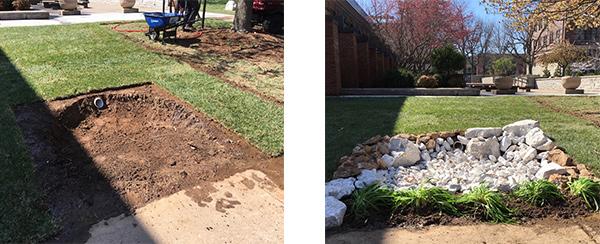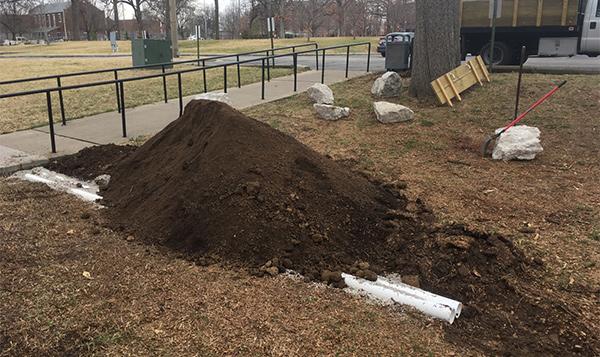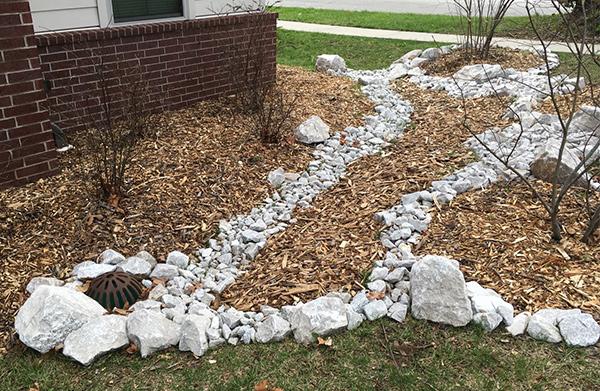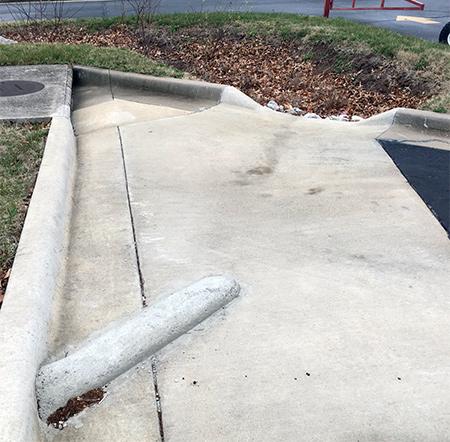Keeping Our Water on Campus...
Water, when it takes the form of rain and stormwater runoff, is both a blessing and a curse. It is a blessing when it irrigates our courses and landscapes, fills our ponds and replenishes groundwater levels. It is a curse when it washes away mulch beds or bunker sand, creates erosion damage, or overwhelms the ability of drain ways to move it out of our landscapes. Which of these consequences it ends up creating is to some extent up to us as Grounds Managers. Creating plans and methods for dealing with stormwater goes a long way to diminishing potential problems, and can help our landscapes get the most out of this most precious commodity.
Start Where the Water Is
Drury Grounds begins managing its stormwater right where it starts to amass on campus. The built environment, topography, and vegetation matrix all have a role in steering water to certain spaces. It is in these collection areas that we have the easiest time controlling where our water will stay, or go next. If we think it should stay at a particular location we have to ask in what manner, and how will it look/function. Small ponds or swales can hold water for short periods and the community understands them readily. Larger collections may need some accommodations (fencing, aeration) and may even need permitting. Determining when to move water is its own process and can be a little more complicated.

Small pools can be located near water source and are easy to install.
If You Need to Move Water Somewhere, Move It Close
This can be tricky. Here at Drury we have a relatively small campus (100+ acres). If the areas where we hold water overflow, we must accommodate and facilitate moving it nearby. Unfortunately for us this usually is into the public stormwater gutters and ditches. But not always. Our biggest rain garden project creates a series of bermed pools that accept overflow from the previous pool. By overlapping crescent shaped ponds we pack a lot of detention into a small space. In a rectangular area of approx. 5K sq. ft., almost all of that area is comprised of detention. The additional benefit of this approach is it didnt require heavy machinery or significant money investment. As a rule, water entering a drain is discharged as close by as possible in an area that allows infiltration.

Move water to nearby areas to allow infiltration.
Interrupt the Water as Many Times as Possible
Water sometimes dictates where it wants to go due to the same physical constraints listed earlier. While water movement in nature alternates between cutting (channelizing) and filling (deposition), these processes need open space to function. Water on our campus gets one path to travel. Limited space does not allow us to utilize large areas for slowing or storing water. In the past, water engineers wanted to get water away as fast as possible using pipes and concrete culverts speeding waters movement. Both of these factors (space/speed) eliminates water that rests in one location to infiltrate or drop contaminants.

Different media slow water before it enters the drain.
Our rationale takes the slow, spread, soak approach. We will use berms/swales, mock gabions, steppes, and of course vegetation (even turf can slow water down!) to create obstacles to water movement. The slower water moves, the less damage it can make, and more soaks in. Sometimes sedimentation can be a concern. This is actually a good thing as solids can be easily removed and can sometimes make a good soil to be used in other projects. Sediment soil can also make good repair material for berms right where it is generated.
Divert Your Gutters
Gutters on the sides of roads are used by most areas as a means to convey water to drains. Normally when storm water hits a gutter it is a one way trip. Here at Drury we have installed several diverters in parking lot gutters that push water into catchments for detention. These catchments are engineered to have maximum detention and percolation. The plants and substrate actually remediates stormwater by allowing large solids to drop out of water when water velocity drops, and through phytoremediation by plants. Physical constraints upstream prevent treatment close to where rainfall initially pools, but guttering moves water effectively to treatment locations. Another benefit is because gutters are installed all over campus already, the movement of water is much less expensive than new construction would be.

Water in the gutter is diverted into a catch basin.
Peripheral Benefits
Water conservation is good press for a grounds operation. These efforts indicate environmental stewardship and create strong partnerships throughout communities. Water conservation efforts can result in additional aesthetic features or interesting design that visitors and patrons appreciate. Water can add plant and organism diversity to a landscape which may help stabilize the landscapes ecologic function. And of course preventing water damage or reusing water saves a lot of money. But ultimately keeping water in our landscapes is about protecting a precious resource that we simply cannot live without.



0 Comments
Recommended Comments
There are no comments to display.